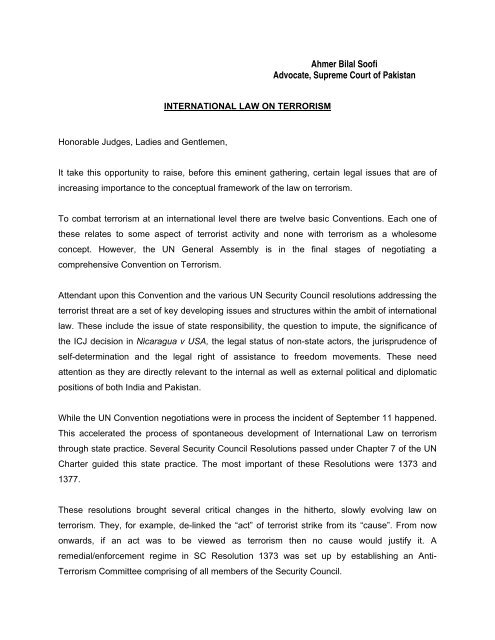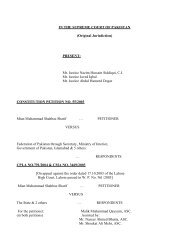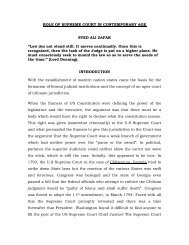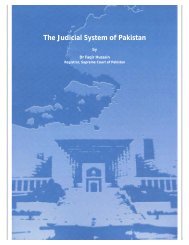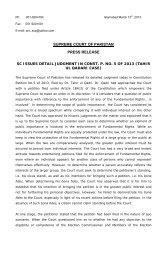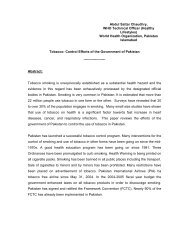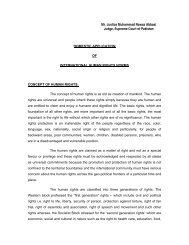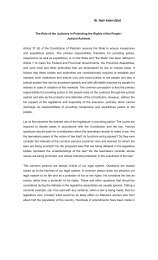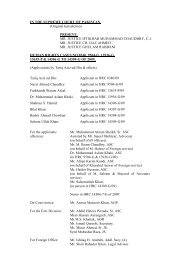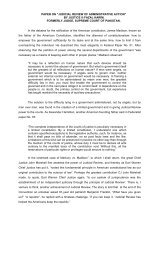Mr. Ahmer Bilal Sufi - Supreme Court of Pakistan
Mr. Ahmer Bilal Sufi - Supreme Court of Pakistan
Mr. Ahmer Bilal Sufi - Supreme Court of Pakistan
You also want an ePaper? Increase the reach of your titles
YUMPU automatically turns print PDFs into web optimized ePapers that Google loves.
1. INTERNATIONAL LAW ON TERRORISM1.1. Treaties and conventions on terrorismLets first enlist major treaties and conventions on terrorism under the auspices <strong>of</strong> the UN:Convention on Offences on-board Aircraft, Tokyo 1963Convention <strong>of</strong> Unlawful Seizure <strong>of</strong> Aircraft, Hague 1973Convention <strong>of</strong> Unlawful Acts against the Safety <strong>of</strong> Civil Aviation, Montreal, 1971Protocol for Acts <strong>of</strong> Violence at Airports, 1988Convention on Crimes against Internationally Protected Persons, 1973Convention on Physical Protection <strong>of</strong> Nuclear Materials 1979Protocol on Safety <strong>of</strong> 6 Platforms in Continental Shelf, 1988Convention against the Taking <strong>of</strong> Hostages 1980Convention against Recruitment, Use, Financing and Training <strong>of</strong> Mercenaries, 1989.Convention on Safety <strong>of</strong> United Nations and Associated Personnel, 1994Convention against Suppression <strong>of</strong> the Financing <strong>of</strong> Terrorism, 1999Convention on the Nuclear TerrorismAll these treaties are in the nature <strong>of</strong> law making treaties and they do not simultaneously serveas a constituent instrument <strong>of</strong> an implementing organization.1.2. No implementing mechanismIt should be noted, that the above conventions primarily create an obligation on the memberstates to cooperate with each other or to carry out prosecution procedures in accordance withtheir domestic laws. They also create an obligation to strengthen their domestic laws, so that itreflects the provisions <strong>of</strong> the above-referred Conventions.In other words, in most <strong>of</strong> these conventions, there is no organization being set up foradministering the text <strong>of</strong> the convention. The administration and the interpretation <strong>of</strong> the text isleft to the states. In the event <strong>of</strong> dispute, regarding the interpretation <strong>of</strong> the text, an option <strong>of</strong>arbitration and subsequent access to International <strong>Court</strong> <strong>of</strong> Justice has been provided.
most <strong>of</strong> these conventions states are induced to emphasize bilateralism rather than resorting toa third party or international organization involvement.This is an attitude evident from the reservations attached by most <strong>of</strong> the states, while ratifyingthe instruments <strong>of</strong> these conventions. As referred above, these conventions do not set upinternational organizations for their implementation. They all carry provisions <strong>of</strong> identical nature,that in case <strong>of</strong> dispute <strong>of</strong> interpretation, the parties may refer the matter to internationalarbitration/failing which put up the issue to the International <strong>Court</strong> <strong>of</strong> Justice. Most <strong>of</strong> theexpressed reservations on the intervention <strong>of</strong> ICJ are to interpret the obligations forimplementation between the parties.This attitude needs to be revisited and the delegations <strong>of</strong> the member states need to bepersuaded that for effective implementation and ensuring cooperative mechanism, there shouldnot be any inhibition to involve an internationally recognized organization to facilitate theprocess <strong>of</strong> cooperation and implementation.It would be appropriate to undertake a study, whereby specific concerns <strong>of</strong> member statesexpressed through reservations are identified in respect <strong>of</strong> each convention. That study wouldalso highlight the subject matter and the scope <strong>of</strong> the convention, as well as the nature <strong>of</strong>bilateral obligation imposed. These issues may arise from domination <strong>of</strong> International Law overdomestic laws or vice-versa and identify precisely the concerns based on which the memberstates have expressed reservations against intervention <strong>of</strong> any international organization for thecooperation under the convention or is it an issue <strong>of</strong> mere political reluctance.For instance, in International convention against the Taking <strong>of</strong> Hostages in 1979, Algeria, China,India, Saudi Arabia, Mexico, Venezuela and Turkey have expressed reservations and resistedthe compulsory adjudication by ICJ on interpretation <strong>of</strong> implementing provisions betweenmember states. Bulgaria in its reservation has actually attempted to broaden the implement ablescope <strong>of</strong> the convention and introduce a concept <strong>of</strong> institutional and ‘governmental’ terrorism asinferred from the language used in the said reservation. Lebanon, likewise, has qualified itsdeclaration to the effect that the right <strong>of</strong> people to oppose and resist foreign occupation <strong>of</strong>territories remains unaffected by virtue <strong>of</strong> the convention.
Again, in the case <strong>of</strong> Convention on Prevention <strong>of</strong> Crimes against the Internationally ProtectedPersons 1973, the pattern <strong>of</strong> reluctance by member states is quite similar. China, Brazil, Korea,Finland, Ghana, Indian, <strong>Pakistan</strong> and several other states have expressed their resistance tothe compulsory adjudication by the ICJ in the event <strong>of</strong> dispute on interpretation.One clear reason for this reluctance seems to be the ambiguous definition <strong>of</strong> “Terrorist Offence”in each <strong>of</strong> the Convention. None <strong>of</strong> the definitions is comprehensive or all encompassing.Therefore, the states feel that ambiguity <strong>of</strong> interpretation may turn against them. Until such time‘terrorism’ is not defined properly, with agreed qualification, the reluctance towardsimplementation shall continue.1.4. Global ratification is a pre-requisite for effective implementationThe member states need to be motivated for ratifying the Conventions. The response <strong>of</strong> thestates for adopting the same is rather less enthusiastic. By 1999, for example the 1979Conventions against Hostages had around 85 parties only. Forty states had signed the samewithout ratifying. It would be useful to evolve a strategy in order to persuade the 40 states,which have not yet signed it to enter and adopt the said convention. Likewise, in another lessorknown Convention <strong>of</strong> 1989 relating to the Recruitment, Use Financing and Training <strong>of</strong>mercenaries, by 1999, there were only 19 states, which had ratified the said convention. The1973 Convention on Crimes against Internationally Protected Persons has been ratified by over102 states. Whereas 1997 Convention on Terrorist Bombing has been ratified only by about 12states.In these circumstances, it is highly desirable that for effective implementation the first and theforemost thing is that the member states should ratify/adopt these conventions. Besidesratifiication they should also at the same time incorporate them into their domestic legislation.Simultaneously, the member states also need to change existing domestic legislation, whichmay not be in conformity with the primary obligations <strong>of</strong> these conventions. Now, there is noeffective monitoring mechanism to oversee whether there is a formal campaign to persuade themember states to adopt the convention. There is no formal mechanism to track the states thathave ratified the conventions, to formally implement them into their local legislation.1.5. Monitoring <strong>of</strong> domestic legislation <strong>of</strong> States parties
The states, which have adopted a given convention through ratification, have no place to put onrecord the domestic legislation, which they have made for the implementation <strong>of</strong> the mainconvention. This is a crucial aspect <strong>of</strong> cooperative mechanism. The domestic legislation in thestates, particularly those, which have ratified the convention, must be taken note <strong>of</strong>, collectedthrough some international monitoring Body.It is suggested that the Terrorism Prevention Branch <strong>of</strong> UN in Vienna may be converted into aseparate Secretariat and entrusted to oversee the process <strong>of</strong> ratification <strong>of</strong> the existingconventions. They should monitor the domestic legislation being made, understand theconcerns and reservations <strong>of</strong> the member states in respect <strong>of</strong> the existing conventions, evolve aprocess <strong>of</strong> assurance and confidence building amongst the member states, as the reservationsmerely creates an embargo in the smooth implementation..The Secretariat suggested to be established for these purposes could be created by theresolution <strong>of</strong> UN Security Council. That seems to be the only shortest possible and effective way<strong>of</strong> creating an organization, which can be given this duty. The existing Anti-Terrorism branch inVienna could be given this assignment. The scope <strong>of</strong> such an organization must include allissues arising from implementation including issues such as the framework <strong>of</strong> terrorism.2. United Nations RESOLUTIONS ON TERRORISMBy virtue <strong>of</strong> several UN Resolutions, passed both at Security Council and at General Assemblyover the last almost two years, the legal jurisprudence <strong>of</strong> law on terrorism has developedtremendously.These Resolutions have considerably filled in the gap left by Treaties or Conventions. Further,they create ‘immediate’ obligations on member states. We all know that Treaty or a Conventionrequires a long time before its text is finalized or it is entered into force.It was interesting that 11 September episode was not covered under any single convention onterrorism. Therefore, one had to look at the spontaneous work <strong>of</strong> Security Council and thenature <strong>of</strong> law on terrorism that it had generated.
The second set <strong>of</strong> Resolutions was passed after September 11 and show a dramaticprogression in the implementation <strong>of</strong> the law against terrorism. We first discuss the resolutionspassed before 11 September.All the resolutions passed by Security Council (SC) before 11 th September are primarily underChapter 7 <strong>of</strong> the UN Charter, which means they have the legal and constitutional force forimplementation.A committee <strong>of</strong> experts was appointed under S.C. Resolution 1333 and another Committee wasestablished under SC Resolution 1267. The monitoring mechanism for these Committees wereidentified in Resolution 1363. The purpose was to <strong>of</strong>fer assistance to the states borderingAfghanistan. SC Resolution 1363 sanctioned the creation <strong>of</strong> enforcement support committee <strong>of</strong>15 members, which specialized in the areas <strong>of</strong> border security, counter terrorism and customsetc. The committee was required to report to SC periodically. Apart from the enforcementsupport team, a Monitoring Group <strong>of</strong> 5 members was also established, in which experts interrorism, finances and money laundering were inducted.Thus, prior to September 11, the above-referred 3 Resolutions <strong>of</strong> SC namely 1363, 1267 and1333 established a coherent regime <strong>of</strong> enforcement <strong>of</strong> anti-terrorism measures, specifically inthe context <strong>of</strong> Afghan issue. However, it must be noticed that since they were related toAfghanistan, there was no issue discussed regarding the outline <strong>of</strong> the nature <strong>of</strong> terrorismactivity that was being referred to. One <strong>of</strong> the basis was that Osama Bin Laden stood indicted inUSA and therefore, was required by SC to be delivered either to USA or to any other thirdcountry. Since the Taliban Regime refused to hand him over, the SC placed the Taliban Regimeunder sanctions and the above-referred mechanism was set into motion for the monitoringpurpose. No need was felt to identify as to what constitutes ‘terrorist activities’.2.4. Resolutions after September 11The 11 th September event however changed this entire scenario. It re-emphasized the need toidentify precisely the features <strong>of</strong> terrorism independent <strong>of</strong> its motives, surrounding
circumstances, and other political issues. The attack <strong>of</strong> September 11 th was a peculiar legalevent, as it was not covered by any single convention on terrorism that was in force at the time.Therefore, the incident unmasked the inadequacy <strong>of</strong> the legal environment to address issues <strong>of</strong>global terrorism. The situation demanded extra-ordinary measures.Resolution 1368 <strong>of</strong> 12 th September was argued to have authorized the collective armed actionin Afghanistan against Taliban Regime. The language generated a legal debate about the limits<strong>of</strong> such authorization.However, under Resolution 1373, adopted on September 28, 2001, the Security Councilestablished an Anti-Terrorism Committee comprising <strong>of</strong> all its members. All member states wereobligated to report to the Committee, reagarding the steps they have taken to implement thisresolution. 1373 is the single most important resolution since it advances the implementationmechanism against terrorism beyond the limits set out in Conventions.On November 12, 2001 Resolution 1377 was passed which re-affirmed that internationalterrorism and its method are criminal and unjustifiable regardless <strong>of</strong> their motivation and in alltheir forms and manifestations.More recently, the Security Council has passed several resolutions that address issues relatingto terrorism including incitement as part <strong>of</strong> terrorism, nuclear terrorism and declaring non-stateactors as terrorist organizations by extending the mandate <strong>of</strong> existing resolutions.3. DEFINITION OF TERRORISMThere is no agreed definition <strong>of</strong> terrorism. In fact, in no single international instrument, ‘terrorism’has been defined, although there are extensive references to ‘terrorism’, or ‘terrorists’, in severalinternational instruments.Ordinarily an indiscriminate use <strong>of</strong> force, without making distinction between protected personsand military targets in order to coerce the government, to act contrary to its will would bereferred to as terrorism.
However, defining terrorism carelessly may have adverse consequence for neighboringconcepts, such as the right <strong>of</strong> self-determination.Drawing a line between the definition <strong>of</strong> terrorism and the use <strong>of</strong> force in genuine exercise <strong>of</strong>right <strong>of</strong> self-determination is likely to be a nightmare.For example, in the 1974 UN General Assembly Resolution aggression was defined, andselective acts were enlisted that may be called aggression. Yet in the same Resolution, it wascategorically stated that nothing in the definition <strong>of</strong> aggression would prejudice the right <strong>of</strong> selfdetermination.In the conventions on terrorism discussed above, each convention defines terrorism withreference to the subject matter that it deals with. Thus, each convention provides limited andrestricted definition <strong>of</strong> a terrorist act covered by the said convention. However, there is nocomprehensive agreed definition <strong>of</strong> what is terrorism. This confusion further compoundsbecause while attempting to define terrorism, the motive <strong>of</strong> a terrorist strike is also forced intothe formulation <strong>of</strong> definition. This is really a non-starter. Because it kick-starts the controversy <strong>of</strong>distinguishing the ‘terrorist’ from the ‘freedom fighter’.Nevertheless, we herein examine how terrorism has been described and referred to, by therecent UN Security Council Resolutions, and how these references have helped evolve theparameters within which the ‘terrorism’ needs to be defined.3.1. Limiting definition <strong>of</strong> ‘terrorism’ to the ‘act’ onlyIn SC Resolution 1377, the paraphrasing <strong>of</strong> condemning terrorism, effectively disassociated thepolitical motive <strong>of</strong> using force from the act <strong>of</strong> terrorism itself. Now terrorist strike is to be dealtwith on stand-alone basis and not to be linked up to the causes associated with it.In other words 1377 stated that we do not care who is carrying out a terrorist strike. We do notcare what the political motive is. We do not care if that motive is right or wrong. Pious ormalafide; if the use <strong>of</strong> force is in the nature <strong>of</strong> a terrorist strike, then the individuals who carry outthat strike will become responsible for the consequences <strong>of</strong> that terrorist strike.
Interestingly, this formulation was not original. 1377 seemed to draw it from various articles bothin the Conventions against Financing <strong>of</strong> Terrorism and in the Terrorist Bombing. However, theConvention did not enjoy the wide adoption to implement this formulation whereas the SCResolution by its very nature was a direct obligation on its members.3.2. Self-determination and terrorismThis formulation <strong>of</strong> the Security Council Resolution has been misunderstood as well. A generaland an over simplified view is that all conceptual arguments justifying use <strong>of</strong> force have endedand therefore, the right <strong>of</strong> self-determination, the right <strong>of</strong> freedom struggles who are using force,stands extinct. This is not a correct view.All that 1377 does is that it merely separates the legality and the justification <strong>of</strong> using force itself.Now onwards the act and event <strong>of</strong> the terrorist strike will be judged on its own merits.For example, if it is against the civilians directly, and no military target is involved thenwhosoever does it ought to be responsible. Likewise, if someone raises out a genuineresistance act against a military use <strong>of</strong> force and in doing so, it inflicts civilian causalities as anancillary damage in that case the said act will not be viewed as a terrorist strike.Therefore, the Resolution 1377 at one level, distances the political justification <strong>of</strong> using forcefrom the act <strong>of</strong> terrorism, and at another level creates a confusion and emphasizes the need toidentify more clearl,y as to what constitutes the ‘terrorist act’? What should be its precisefeature? What should be identified as an act <strong>of</strong> terrorism, for which an organization, group <strong>of</strong>people or a state could be held responsible? If the act in question is, by its very nature a‘terrorist act’, then only the individual perpetuator <strong>of</strong> the said act must be held responsible. Thatperpetuator could be a freedom fighting movement, it could be a guerilla movement, it could bea government, it could be group <strong>of</strong> people and it could be a genuine ‘terrorist act’.This is a dramatic forward position in the understanding and perception <strong>of</strong> the concept <strong>of</strong>‘terrorist act’. Whosoever, has to be entrusted with the responsibility for the implementation andmutual cooperation has also to undertake this assignment to make it clear, that the motives <strong>of</strong>terrorist strike will have no bearing on the legality <strong>of</strong> the purpose <strong>of</strong> strike. Further, who willidentify exactly the features <strong>of</strong> a terrorist strike? This would be the main controversy in the
process <strong>of</strong> implementation. Security Council understandably did not have time to resolve thiscontroversy.One feels that this issue needs to be highlighted much more clearly. In this regard, it issuggested that given the parameters in Resolution 1377, which is to be read into 1373 as well, itwould be now necessary to:a) Define and identify the features <strong>of</strong> terrorist strike;b) Disassociate the terrorist strike from the legality, justification or illegality <strong>of</strong> the motives; andc) Restrict responsibility to the individual unless there is court worthy evidence <strong>of</strong> linkage to anyentity <strong>of</strong> state, or a state itself.3.3. International Humanitarian Law and definition <strong>of</strong> terrorismThe legal regime <strong>of</strong> International Humanitarian Law can be used to identify the features <strong>of</strong> whatought to be terrorism. Terrorism would be extremely close to the violation <strong>of</strong> InternationalHumanitarian Law. As we know that the entire customary and treaty framework <strong>of</strong> IHL includingGeneva Conventions and Hague Regulations etc. prohibit direct targeting <strong>of</strong> protected persons,but does allow ancillary damage in case <strong>of</strong> military necessity. The definition <strong>of</strong> terrorism needsto be pegged close to this framework. But in the case <strong>of</strong> IHL, where legality or justification <strong>of</strong> use<strong>of</strong> force is not relevant, the use <strong>of</strong> force or its motive will have no relevance or bearing on thestrike. The event <strong>of</strong> terrorist strike has to be assessed on its own.3.4. Rome Statute and definition <strong>of</strong> terrorismIn this regard, <strong>Pakistan</strong> delegation would also invite the attention to Articles 8 & 9 <strong>of</strong> theInternational Criminal <strong>Court</strong> or the Rome Statute. The said provision enlists in detail the specificacts that constitute war crime and genocide. An event <strong>of</strong> terrorist strike either would beduplicating any <strong>of</strong> those specific events or could be in close conceptual proximity <strong>of</strong> the said
concepts. Nevertheless, article 8 & 9 <strong>of</strong> the ICC do provide a very valuable basis for undertakingthe work to identify the features <strong>of</strong> a terrorist act.3.5. Why definition <strong>of</strong> terrorism should be restrictive?In other words while undertaking the process <strong>of</strong> defining terrorism or locating its features withinthe parameters laid down in SC Resolution 1377 for effective implementation, it is absolutelynecessary to de-link from the reasons for undertaking the terrorist strike. Therefore, as long asthe definition <strong>of</strong> terrorism excludes the motive, the purpose and the background, the scope <strong>of</strong>controversy will stand reduced and the member states will feel much more comfortable to agreeon consensual definition <strong>of</strong> terrorism and then enter necessary cooperation.Thus, on one hand, it will enable consensus on the terrorism definition, And on the other it willallow those states, which have sensitivity to support freedom fighters movements or movementsfor self-determination or genuine political resistance to continue with their support, sincemovements or the freedom struggle, as the case may be.3.6. Necessity for defining terrorism in the context <strong>of</strong> mutual assistanceThe issue <strong>of</strong> mutual legal assistance on the preventive side is where the implementationprocess is clearly lacking. The state parties shall take practical measures to prohibit in theirterritory, activities by people or organizations which may constitute the <strong>of</strong>fence under theconvention itself. Such provision inherently suffers from a grey area, since it is not quite certainthat at what stage preventive measures are to be taken? How would the parties communicatewith each other in terms <strong>of</strong> the outline <strong>of</strong> the <strong>of</strong>fence that is to be covered by the internationalconvention?For example, Article 5 <strong>of</strong> the 1997 Convention on Terrorism Bombing incorporates in itsdefinition certain elements <strong>of</strong> terrorism strike. However, it still leaves plenty to guess. Forexample, it says it will be an <strong>of</strong>fence where the intention is to ‘prove’, a state <strong>of</strong> terror in generalpublic or in a group <strong>of</strong> people or particular person, which will not be justifiable on political,ideological or religious grounds. Again, it is less clear what precisely would be the nature <strong>of</strong><strong>of</strong>fence in respect <strong>of</strong> which, there is a desire for mutual legal assistance.
Therefore, we cannot help notice the necessity for arriving at a consensual definition <strong>of</strong>terrorism which shall encompass the details and also comprehensively attend to all issues <strong>of</strong> theevent, irrespective <strong>of</strong> its justification.4. OTHER OBLIGATIONS UNDER THE UN RESOLUTIONS4.1. Obligation to resolve regional conflicts: Kashmir for instance1377 stresses the member states to address regional conflicts that are a hurdle in the possiblefight against international terrorism. Thus, 1377 raises the fundamental issue <strong>of</strong> addressing thequestions <strong>of</strong> reasons <strong>of</strong> terrorism and removing their causes. That is why in 1377 the word‘addressing regional conflicts’ has been used. It is common knowledge that resorts to terrorismis an extreme act <strong>of</strong> frustration on part <strong>of</strong> certain resistance movements. The act certainlycannot be justified. Nevertheless it is based on extreme disappointment, and after knowing thattheir political solutions have failed and completely turned down.Therefore, it would be particularly urgent that within the framework <strong>of</strong> resolution 1377, allregional conflicts, or all places where terrorist strikes take place must be examined andmeasures be undertaken for political resolution, especially,where it is reasonably evident thatterrorist strikes are a frustrated outcome <strong>of</strong> political failure or disappointment.For example, in the recent case <strong>of</strong> Sri Lanka, it has been noticed that the terrorist strikes byTamils have significantly reduced after an attempted political resolution <strong>of</strong> the issue. It was thusevident that the Tamil strikes were an act <strong>of</strong> extreme disappointment. Therefore, addressingregional conflicts within the framework <strong>of</strong> any resolution,is an issue <strong>of</strong> grave importanceSame could be mentioned in the case <strong>of</strong> the territories <strong>of</strong> Kashmir, where people inside thevalley have been struggling for their right <strong>of</strong> self-determination, and having beencomprehensively frustrated by the Indian Government’s active discouragement and repressionwho did not consider their genuine political demand. In certain cases, Kashmiri’s resorted toviolent means, which were viewed as acts <strong>of</strong> terrorism. Therefore, they are a classical example<strong>of</strong> “regional conflicts” within the meaning <strong>of</strong> Resolution 1377, which must be addressed by UNSecurity Council in the process <strong>of</strong> implementation.
It is well known that the state, which presumably suffers the act <strong>of</strong> terrorism, uses the argument<strong>of</strong> anticipatory individual self-defence in terms <strong>of</strong> Article 51 to strike back at the state to which itattributes the terrorism. This right <strong>of</strong> individual self-defence is alive until such time SC has nottaken cognizance <strong>of</strong> the issue. Once the SC is seized <strong>of</strong> the matter, then the right <strong>of</strong> unilateralstrike by a member state is curtailed tremendously. Under 1373, SC is seized <strong>of</strong> the matter onterrorism and therefore inherent individual and collective rights <strong>of</strong> self-defence in terms <strong>of</strong> article51 <strong>of</strong> the UN Charter stands displaced. This needs to be highlighted for the member states that1373 being cognizant <strong>of</strong> anti-terrorism activities has drastically curtailed the individual right tostrike against terrorism.4.2. State or institutional terrorism: more questions than answersSimilarly, the concept <strong>of</strong> institutional terrorism stands retained and it would create complicationat the stage <strong>of</strong> implementation. One may invite attention to Article 19(2) <strong>of</strong> the Convention onTerrorist Bombing. Here rightly so, the use <strong>of</strong> bombs during armed conflict stands excluded.However, the use <strong>of</strong> organized weaponry <strong>of</strong> the explosive nature, which creates a state <strong>of</strong> terrorin the general public is not excluded and therefore, it is quite evident that any action by thepolice authorities <strong>of</strong> a state, against its subjects would be an <strong>of</strong>fence itself if it fulfills thedefinition..Thus, we are straightforwardly talking <strong>of</strong> a state sponsored terrorist act where effectively theentire features <strong>of</strong> definition <strong>of</strong> terrorist strike are fulfilled. The state institution itself does it, and itis done against its own subjects. In this eventuality although in terms <strong>of</strong> technical issue, there isno international element and therefore, the Convention may not be applicable. Nevertheless, itleaves at a political level; a very general dissatisfaction on part <strong>of</strong> the state itself that it isextremely irresponsible treatment <strong>of</strong> its local affairs can go unguarded and can given a right tocall for individual or a few individuals across the border, which might be in the third state.This anomaly in the implementation regime needs to be addressed at a certain stage or acertain level.4.3. Summing up the legal points in the twelve Conventions on Terrorism
From the reading <strong>of</strong> the relevant provisions in the 12 Conventions on extradition, mutual legalassistance and law cooperation, the following points and positions emerge;States that are parties to these Conventions cannot act ‘outside the relevant Convention’ toachieve the objects <strong>of</strong> the Convention. They are bound to resort to the implementingmechanism within the Convention. Use <strong>of</strong> force to achieve any objective that is within the scope<strong>of</strong> the Constitution, is contrary to spirit <strong>of</strong> uniform implementation <strong>of</strong> the Convention; [2]Most <strong>of</strong> the <strong>of</strong>fenses in the Conventions are being treated as <strong>of</strong>fences <strong>of</strong> universal jurisdiction(any state can try without a duty to extradite);Terrorism is being treated in Conventions also as an <strong>of</strong>fense at par with the <strong>of</strong>fences havinguniversal jurisdiction;Therefore, the obligation on a requested state to extradite a terrorist, under the conventions isnot absolute. In other words, within the reason given in the Conventions, the extradition can berefused;In case state refuses extradition, then it has a duty to prosecute the <strong>of</strong>fender. Provided sufficientinformation is given by the state that requested extradition;All Conventions make only individuals and not the state, responsible for the acts <strong>of</strong> terrorism;In all 12 Conventions, the States to which the terrorist may belong are not held responsible forthe acts <strong>of</strong> its nationals having terrorist nature. There are no provisions to spell out any liabilityagainst the state to which the <strong>of</strong>fender may belong;Some Conventions provide general cooperative obligation on the state parties to take‘measures to prohibit in their territories illegal activities <strong>of</strong> persons, groups etc’ [3]. However,there are no penal consequences provided in text <strong>of</strong> any convention, if the same is not done.Therefore, the said obligation is persuasive in nature and failure to do so would not imply breach<strong>of</strong> obligations under the Convention;
Such cooperative measures would include legislative or executive orders to declare suchactivities illegal. None <strong>of</strong> the Convention requires the Member State to achieve completeelimination <strong>of</strong> terrorist related activities or groups. The words used are to effect ‘measures toprohibit’ [4] and not “will ensure complete elimination <strong>of</strong> terrorist activities”.Therefore, once the state takes legislative and administrative measures to ban the suspectedgroups, it is deemed to have fulfilled its obligations under the Convention concerned;Conventions are not applicable on military forces <strong>of</strong> states when they commit acts qualifying<strong>of</strong>fences <strong>of</strong> terrorism. However, it appears that members <strong>of</strong> local police force are not exemptedfrom individual liability if their acts qualify as a terrorist act; [5]The definition <strong>of</strong> terrorism in each <strong>of</strong> the 12 Conventions is limited within the framework andscope <strong>of</strong> the Convention. Thus, none <strong>of</strong> them is a comprehensive definition;The 12 Conventions confine their definition <strong>of</strong> each terrorist act with reference to the event oract <strong>of</strong> terrorism. None <strong>of</strong> them adversely comments on the motive and purpose <strong>of</strong> those whocarried out the terrorist attack. None <strong>of</strong> the Convention declares the motive and purpose asillegal, merely because they used forced in the nature <strong>of</strong> terrorist strike. In fact, it protects themotive or purpose. [6] Likewise, Resolution 1373 disassociates motive from the event;Therefore, the purpose and motive behind carrying out the terrorist strike remains unaffected. Inother words if the individuals representing freedom movements are found attributed to an act <strong>of</strong>terrorism then only they will be responsible in their individual capacity and the movement itselfshall not suffer any adverse legal consequences; perhaps apart from political loss;Terrorist bombing is a ‘strict liability <strong>of</strong>fence’. Under this, the connection <strong>of</strong> the <strong>of</strong>fendingindividual needs to be established with that <strong>of</strong> the fact, and not mental intent needs to beestablished. Thus, the motive is in any case irrelevant;The Convention on the Financing <strong>of</strong> Terrorism allows use <strong>of</strong> force by freedom movementagainst the Government in peaceful time. The <strong>of</strong>fence <strong>of</strong> terrorism, as defined in article 2(b)makes it clear that terrorist strike to coerce a government is terrorism only during armed conflictsituation; and
The Convention against Financing <strong>of</strong> terrorism requires extensive domestic legal measures forfinancial discipline. Government <strong>of</strong> <strong>Pakistan</strong> is doing the same through an Anti-CorruptionStrategy being evolved by NAB4.4. UN Draft Convention on TerrorismAs we have mentioned above, before 11 Sept, there were 12 basic international Conventionsrelating to terrorism. Most <strong>of</strong> them related to only selective aspects <strong>of</strong> terrorism i.e. hijacking,civil aviation, nuclear materials and platforms in Continental Shelf etc. None <strong>of</strong> the Conventionaddressed or defined terrorism as a wholesome concept. Thus, a need was felt for acomprehensive convention on terrorism directly. In this regard, UN General Assemblyestablished a Special Committee called the 6 th Committee and tasked it to prepare a draft <strong>of</strong> thisConvention. In this regard, the draft submitted by India was accepted for discussions. Now afterseveral sessions, the text <strong>of</strong> the Convention is almost finalized except preamble and thedefinition <strong>of</strong> terrorism.Conclusion:In order to fight terrorism, we need to evolve constructive strategy for legislative harmony thatwould allow successful prosecution <strong>of</strong> terrorists, their advance approach in laundering anddisguising their assets.The existing conceptual framework <strong>of</strong> international law, as evident from this paper, is notsufficient to respond to the challenges that states face; including <strong>Pakistan</strong>.<strong>Pakistan</strong>i statute on terrorism is comprehensive and charges can be framed under it in respect<strong>of</strong> most <strong>of</strong> the <strong>of</strong>fences <strong>of</strong> terrorism in the international conventions.________________________[1] Advocate <strong>Supreme</strong> <strong>Court</strong> <strong>of</strong> <strong>Pakistan</strong> and President Research Society <strong>of</strong> International Law.[2] India’s military built up is thus contrary to the spirit <strong>of</strong> the cooperation on implementing mechanism.[3] Article 15(a) <strong>of</strong> the Convention on Terrorist Bombing 1997.[4] Ditto.[5] Article 1(4) and 19(2) <strong>of</strong> the Convention on Terrorist Bombing 1997.
[6] Article 19(1) <strong>of</strong> the Convention on Terrorist Bombing 1997.


